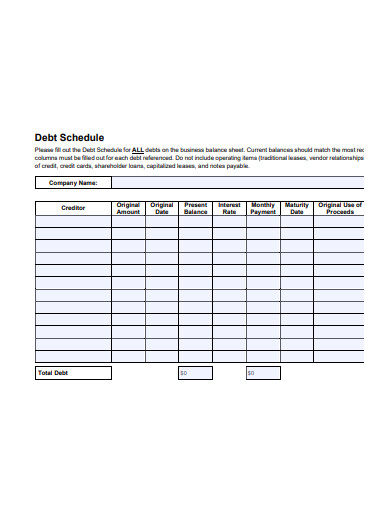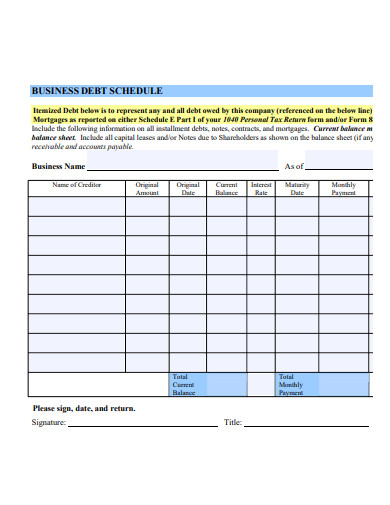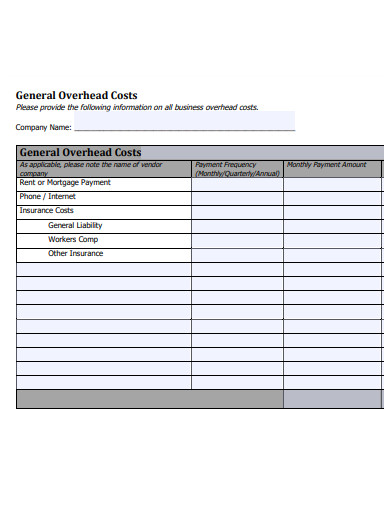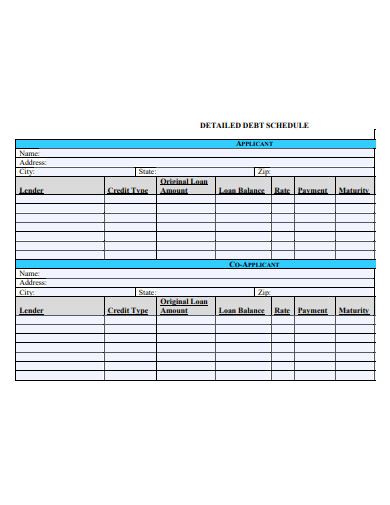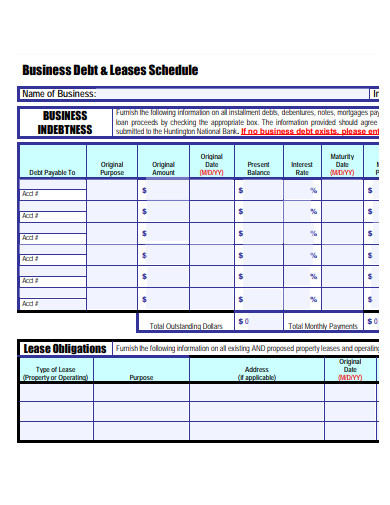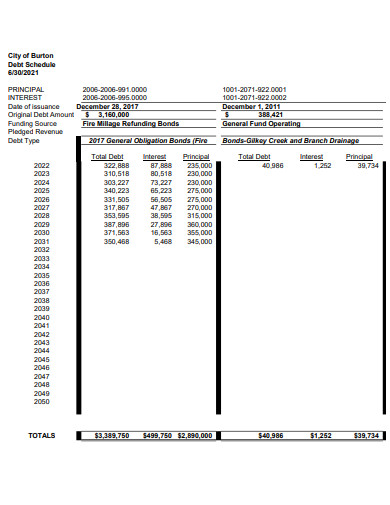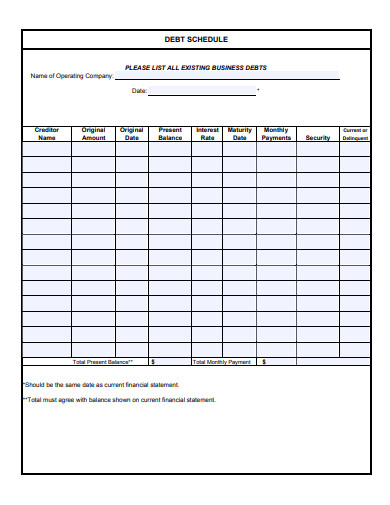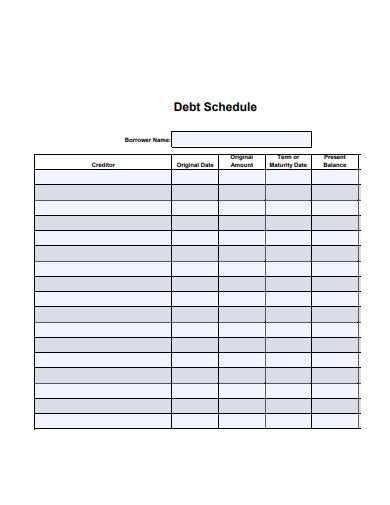Every organization has funding sources and applications; the funding sources can be owned or owes monies. Interest is charged on borrowed funds, which must be paid by the organization. It contains information about the organization’s debts to others; in other words, it contains information about owed funds. The due fund contains interest-bearing outside borrowings used in the firm. It also includes the amount borrowed, interest expenditures, and debt repayment amounts. The company must examine the need, interest rate, and present value before requesting for financing, the benefits of using it, the maturity length, the repayment schedule, and other factors to determine whether accumulating debt will be beneficial or not.
10+ Debt Schedule Samples
Debt Schedule is a list of liabilities that a corporate owes, such as term loans, debentures, and cash credit, that industry groups organize in order to find the actual amount of liability they end up paying to others and manage their cash flows in order to avoid financial crisis and facilitate effective debt management. A debt schedule normally excludes short-term business expenses like accounts payable, salaries, and real estate taxes. Payroll and taxes, for example, are accounted for on the balance sheet of your company. Financial managers can acquire an accurate estimate of the company’s longer-term debt burden by maintaining debt distinct from these short-term expenses.
1. Debt Schedule
2. Business Debt Schedule
3. Property Debt Schedule
4. Overhead and Debt Schedule
5. Detailed Debt Schedule
6. Personal Debt Schedule
7. Business Debt and Leases Schedule
8. Government Debt Schedule
9. Sample Debt Schedule
10. Debt Schedule Example
11. Printable Debt Schedule
Uses of Debt Schedule
A debt schedule can help you gain a bird’s-eye view of all your loans and create a cash flow analysis for your company. A business debt schedule brings various advantages to your company in addition to tracking financial obligations:
Keep up with your debt payments: Using a debt schedule, you can see all of the amounts you owe each month at a glimpse. This is one of the tool’s most critical features, because nothing is more damaging to your company’s financial performance than paying your obligations late or not at all.
Maintain accuracy in your books: Having all of your debt information readily available is an excellent approach to ensure that your debt schedule complements your other accounting practices. Interest expenses mentioned in the debt schedule, for instance, will reflect on your income statement, while principle repayments will reflect on your cash flow statement.
Negotiate favorable terms: If you have a track record of timely payments on an outstanding loan, you may be able to pay it back at a cheaper interest rate. The debt schedule shows which loans have the greatest interest rates and monthly payments, which can aid in refinancing initiatives.
Plan your payments: Using a debt schedule, you can understand the strategic advantages of paying off specific debts early. If you have the financial capacity to accelerate any of your payments, you can decide which ones to pay off first.
Make borrowing moral choices: Understanding your overall debt and monthly payments can help you determine whether you can manage to borrow more. If a new loan doesn’t fit into this fiscal situation, you’ll know immediately if you should wait till your situation improves.
Provide correct information: The details on your debt schedule can be utilized to enlighten potential new lenders, creditors, and even local investors about your company’s financial statistics in a variety of ways. Having all of this information in one location makes it easier to generate the necessary reports.
Track your company’s financial performance: The debt schedule is an important component of the overall picture of how your firm is doing financially. You’ll be able to notice if the totals for balances and monthly payments are excessively high right away and devise a strategy to reduce them.
FAQs
What are regular expenses?
Regular business expenses such as short-term accounts payable and accrued liabilities are typically not included in your debt schedule. This form is for you, the business owner, to quickly and simply examine your company’s present debt in case you need to make a decision, such as taking on new debt, determining where to repay first, or seeking to bargain with a creditor.
What is the role of an interest rate in the debt schedule?
In the structure of debt, the interest rate is equally crucial. If the interest rates are good, the only option is to take out a loan because interest is an expense for the company.
The debt schedule is a list of the institution’s debts, which includes debentures, term loans, bonds, and leases, among others. It assists the organization in generating sound financial decisions. Restructuring of debt also aids in the tracking of debt maturity dates. It assists investors in making investing selections. When applying for various sorts of debt, numerous elements such as interest rate, repayment schedule, and so on must be considered.
Related Posts
FREE 10+ Gym Schedule Samples in PDF | MS Word | Apple Pages | Google Docs | Keynote |
FREE 10+ Daily Hourly Schedule Samples in PDF
FREE 10+ Weekly Schedule Template with Hours Samples in PDF
FREE 10+ 7 Day Weekly Schedule Samples in PDF
FREE 10+ Working Schedule Template Samples in PDF
FREE 6+ Preschool Schedule Template Samples in PDF
FREE 10+ Daily School Schedule Samples in PDF | MS Word | Google Docs | Google Sheets | Excel
FREE 10+ Day Schedule Samples in PDF
FREE 10+ Daily Work Schedule Samples in PDF
FREE 10+ 24 Hours Schedule Samples in PDF | Word | Google Docs | Google Sheets | Excel | Apple Numbers | Apple Pages
FREE 10+ Baseball Schedule Samples in PDF
FREE 10+ Availability Schedule Samples in PDF
FREE 10+ Weekly Cleaning Schedule Samples in PDF
FREE 8+ Employee Scheduler Template Samples in PDF
FREE 10+ Weekly Work Schedule Samples in PDF

